
Jan . 02, 2025 05:52
Back to list
صمام تنظيم الضغط
Understanding Pressure Regulating Valves Functions and Applications
Pressure regulating valves (often abbreviated as PRVs) are critical components in various industrial systems and processes. Their primary function is to maintain a desired pressure level within a system, ensuring that operations function smoothly and safely. This article delves into the mechanism, types, importance, and applications of pressure regulating valves.
What is a Pressure Regulating Valve?
A pressure regulating valve is a device that automatically adjusts and maintains the pressure of fluid within a system at a predetermined set point. PRVs are essential in managing the flow and pressure of gases and liquids, preventing system overloads, and promoting efficient operation.
How Do Pressure Regulating Valves Work?
At the heart of a pressure regulating valve is a spring-loaded mechanism. When fluid enters the valve, it exerts pressure against a diaphragm or piston. This pressure is balanced by the spring tension. If the fluid pressure exceeds the set point, the diaphragm or piston moves to open the valve, allowing excess fluid to escape and reducing pressure. Conversely, when the system pressure drops below the set point, the valve closes partially to maintain the desired pressure.
The adjustment features of PRVs provide flexibility in their application, enabling users to modify pressure based on specific needs. Some valves have an adjustable spring tension, allowing operators to set different pressure levels based on system requirements.
Types of Pressure Regulating Valves
There are various types of pressure regulating valves, each designed for specific applications
1. Spring-Loaded Pressure Regulators The most common type, these regulators rely on a spring mechanism to maintain pressure. They are widely used in gas and liquid applications.
2. Diaphragm-Type Regulators These employ a flexible diaphragm that reacts to pressure changes, providing precise pressure control. They are commonly found in petrochemical and water treatment processes.
3. Electronic Pressure Regulators These advanced devices utilize electronic sensors and actuators to maintain pressure, offering high accuracy and remote monitoring capabilities.
4. Back Pressure Regulators Designed to maintain a certain upstream pressure in a system, back pressure regulators are crucial in processes where constant upstream pressure is necessary.
Importance of Pressure Regulating Valves
صمام تنظيم الضغط

The significance of pressure regulating valves cannot be overstated. They play a vital role in various applications
1. Safety By preventing overpressure conditions, PRVs enhance the safety of systems, reducing the risk of equipment failure and accidents.
2. Efficiency Maintaining optimal pressure ensures that systems operate efficiently, reducing energy consumption and operational costs.
3. Fluid Control In processes requiring precise fluid control, PRVs help achieve consistent quality by regulating flow and pressure.
4. Equipment Protection By controlling pressure, these valves protect downstream equipment from potential damage caused by pressure surges.
Applications of Pressure Regulating Valves
Pressure regulating valves find applications across multiple industries, including
- Oil and Gas PRVs are extensively used in pipelines and refineries to control gas and liquid pressures. - Water Treatment They help regulate pressure in water treatment plants, ensuring proper filtration and treatment processes.
- Chemicals In chemical manufacturing, maintaining consistent pressure is essential for reaction efficiency and safety.
- HVAC Systems In heating, ventilation, and air conditioning systems, PRVs regulate refrigerant pressures, enhancing system performance.
- Food and Beverage PRVs help maintain consistent pressure during processing and packaging, contributing to product quality and safety.
Conclusion
Pressure regulating valves are indispensable instruments in modern industrial applications. Their ability to maintain and control pressure not only ensures operational efficiency but also guarantees safety across various processes. Understanding how these valves work and their applications can help industries optimize their operations and safeguard their systems. With ongoing advancements in technology, the effectiveness and precision of pressure regulating valves continue to improve, making them a key component in fluid and gas control systems.
Next:
Latest news
-
Safety Valve Spring-Loaded Design Overpressure ProtectionNewsJul.25,2025
-
Precision Voltage Regulator AC5 Accuracy Grade PerformanceNewsJul.25,2025
-
Natural Gas Pressure Regulating Skid Industrial Pipeline ApplicationsNewsJul.25,2025
-
Natural Gas Filter Stainless Steel Mesh Element DesignNewsJul.25,2025
-
Gas Pressure Regulator Valve Direct-Acting Spring-Loaded DesignNewsJul.25,2025
-
Decompression Equipment Multi-Stage Heat Exchange System DesignNewsJul.25,2025

